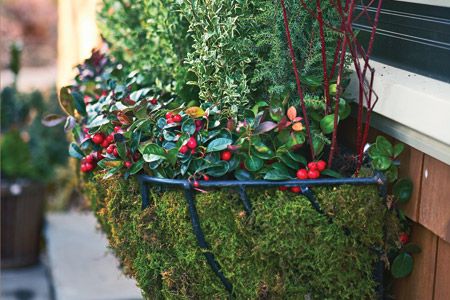Winter doesn’t have to mean the end of your garden’s beauty. With the right plants, containers, and care techniques, you can create a stunning outdoor space that thrives even in cold weather. This guide will explore how to choose and maintain cold-hardy plants, select appropriate containers, and design eye-catching winter gardens that will keep your landscape vibrant throughout the chilly months.
Understanding Cold-Weather Plants
Cold-weather plants are specially adapted to survive and even flourish in low temperatures. These hardy species have developed unique characteristics that allow them to withstand frost, snow, and freezing conditions.
What Defines a Cold-Hardy Plant?
Cold-hardy plants possess several adaptations that enable them to survive winter conditions. These include:
- Dormancy mechanisms that slow growth during cold periods
- Antifreeze compounds in their cells to prevent ice crystal formation
- Thick, waxy coatings on leaves to reduce moisture loss
- Deep root systems that can access unfrozen soil
Plants are rated on a hardiness scale, which indicates the lowest temperature they can tolerate. When selecting plants for your winter garden, choose those rated for your specific USDA Hardiness Zone or colder.
Benefits of Cold-Weather Gardening
Embracing cold-weather gardening offers several advantages:
- Extended growing season and year-round interest in your landscape
- Reduced competition from pests and diseases that are dormant in winter
- Opportunity to grow unique plants not suitable for warmer seasons
- Increased habitat and food sources for winter wildlife
Cold-weather gardening allows you to enjoy your outdoor space even during the coldest months, providing a refreshing connection to nature year-round.
Challenges of Gardening in Cold Weather
Cold-weather gardening isn’t without its challenges. Some difficulties you might face include:
- Soil that is more challenging to work with when it’s cold and possibly frozen
- Limited daylight hours which can slow plant growth
- Cold winds that can damage or dry out plants
- The necessity for additional measures such as mulching and covering plants
By understanding these challenges, you can develop strategies to mitigate them.
Choosing the Right Container for Winter
Selecting appropriate containers is important for the success of your cold-weather plants. The right pot will protect roots from freezing and provide stability in harsh conditions.
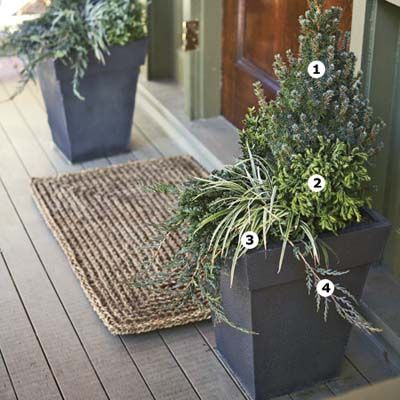
Here, Blue Alberta spruce (Picea glauca ‘Sanders Blue’) (1) towers over sawara false cypress (2), Japanese rush (Acorus gramineus ‘Ogon’) (3), and creeping juniper (Juniperus horizontalis ‘Bar Harbor’) (4) in pots flanking a door.
Cold-Hardy Container Materials
Not all materials can withstand winter’s freeze-thaw cycles. Choose containers made from:
- Metal
- Plastic
- Fiberglass
- High-fired ceramic
- Concrete mixed with polymers
- Wood
Avoid standard terracotta or low-fired ceramic pots, which can crack when water inside freezes and expands. As Roger Cook, landscape contractor for This Old House, explains, “Water expands about 9% as it turns to ice, so even a one-time freeze can crack containers made of terra-cotta or other brittle, moisture-absorbing materials.”
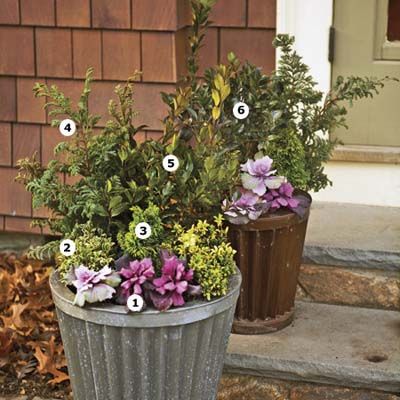
A metal container sets off rosettes of ornamental kale (1), variegated boxwood (Buxus sempervirens ‘Variegata’) (2), and yellow-green dwarf hinoki cypress (Chamaecyparis obtusa ‘Nana Aurea’) (3). Feathery sawara false cypress (Chamaecyparis pisifera ‘Boulevard’) (4) and shiny-leaved common boxwood (Buxus sempervirens ‘Graham Blandy’) (5) serve as the backdrop. Many of these plants also team up nicely with blue holly (Ilex x meserveae ‘Blue Maid’) (6).
Size and Insulation Considerations
Larger containers provide better insulation for plant roots. Choose pots at least 14 inches in diameter and depth. To further protect roots:
- Line wire containers with sheet moss or coir mats
- Add a layer of gravel at the bottom for drainage
- Use landscape fabric to prevent soil loss
- Fill with high-quality potting mix
- Leave 3–4 inches of space at the top for mulch
Proper insulation and drainage will help your plants survive even the coldest winters.
Additional Container Protection Tips
In addition to choosing the right material and size, consider these tips:
- Elevate containers off the ground using pot feet or bricks to avoid direct contact with cold surfaces
- Group containers together to create a microclimate, providing mutual heat benefits
- Insulate containers with bubble wrap or burlap during extreme cold snaps
These strategies can offer extra layers of protection for your plants.
Top Cold-Tolerant Plants for Your Garden
Selecting the right plants is key to a successful winter garden. Here are some top choices for cold-weather plantings.
Evergreen Shrubs and Trees
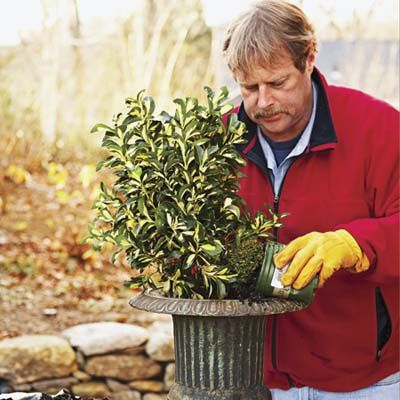
Evergreens provide structure and color throughout the winter. Some excellent options include:
- Dwarf conifers (grow 1–6 inches per year)
- Miniature junipers
- Variegated boxwood
- Hinoki cypress
- Blue spruce
These plants offer a range of colors and textures to keep your garden interesting all season long.
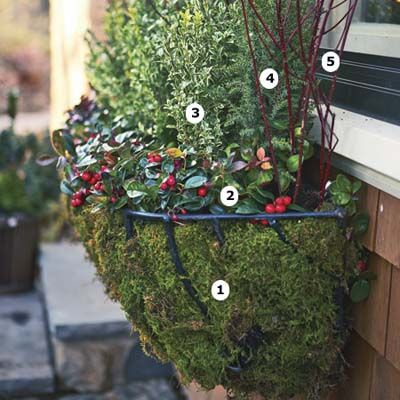
Above, sheet moss forms a base for the bright red berries and shiny leaves of wintergreen (Gaultheria procumbens). Taller variegated boxwood (1), miniature juniper (Juniperus communis ‘Compressa’) (2), and redtwig dogwood branches (Cornus sericea) (3) line the back of the wire window box.
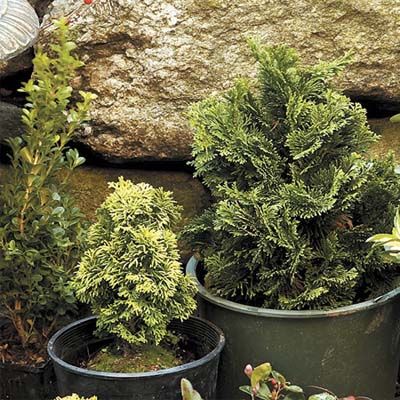
Small conifers, or needled evergreens, work particularly well in planters. You can find ones that form balls, cones, and columns, as well as varieties that trail—an especially useful habit in composing a container. The needles offer variety, too, from soft-textured cypresses.
Winter-Blooming Flowers
For pops of color in milder climates, consider:
- Pansies
- Iceland poppies
- Primroses
- Hellebores (Christmas roses)
In colder regions, ornamental kale provides flowerlike foliage in shades of pink, cream, and green.
Ornamental Grasses and Sedges
Grasses add movement and texture to winter gardens. Try:
- Japanese rush (Acorus gramineus ‘Ogon’)
- Blue fescue
- Sedges (Carex species)
These plants maintain their structure even when covered in frost or snow.
Cold-Hardy Perennials
To add a touch of resilience and color, consider cold-hardy perennials:
- Bergenia
- Heuchera (Coral Bells)
- Ajuga (Bugleweed)
- Lamium (Dead Nettle)
Cold-hardy perennials can enhance the beauty and durability of your winter garden.
Essential Care Tips for Cold-Weather Plants
Proper care is essential for helping your plants thrive in winter conditions. Follow these tips to keep your garden healthy.
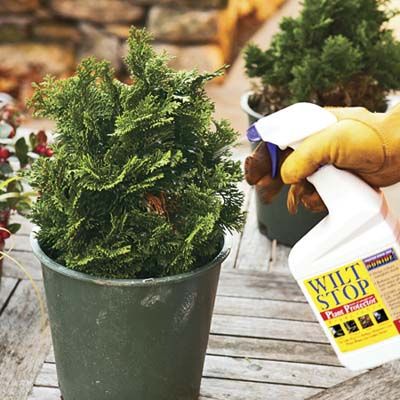
Watering Techniques in Freezing Temperatures
Water your plants when temperatures are above freezing. Check soil moisture regularly by poking your finger into the soil. If it feels dry, water thoroughly. Avoid watering when temperatures are below freezing, as this can lead to ice formation and damage roots.
Mulching for Root Protection
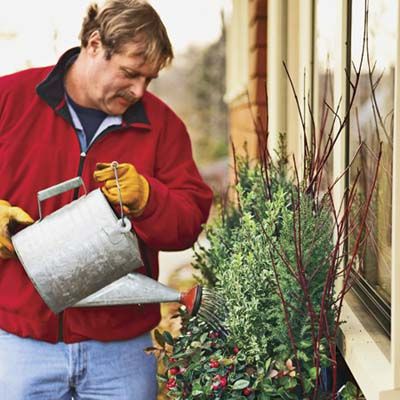
Apply a 3–4 inch layer of mulch around your plants to insulate roots and retain moisture. Cook recommends using aged pine bark mulch. This thick layer protects roots from freezing and prevents them from being pushed out of the soil during hard freezes.
Using Antidesiccants to Prevent Winter Burn
Antidesiccants help evergreens retain moisture and prevent winter burn. Cook suggests using a pine tree resin-based product. Apply according to package instructions, typically in late fall and once during winter. This treatment is especially important for cut branches used in winter arrangements.
Monitoring for Pests and Diseases
Even in the cold, you should be vigilant for pests and diseases:
- Check for signs of rodent damage, which can be more prevalent in winter
- Inspect plants for fungal infections that might develop in the damp and cold
- Remove any dead or diseased plant material promptly to avoid spreading
These preventive measures will maintain the overall health of your garden.
Stunning Winter Container Combinations
Designing attractive winter containers is an art that combines color, texture, and form. Here are some strategies to create eye-catching displays.
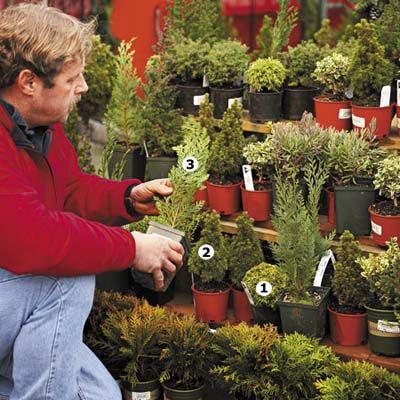
Above, Cook shops for miniature conifers, which come in balls (1), cones (2), and columns (3) that are sized right for containers.
Color and Texture Strategies
Mix plants with different colors and textures for visual interest. Try combining:
- Blue-green conifers with golden cypress
- Variegated boxwood with deep green holly
- Silvery juniper with red-berried wintergreen
Use colorful twigs, such as red dogwood branches, to add height and contrast.
Layering Techniques for Visual Interest
Create depth in your containers by layering plants:
- Place taller plants at the back of the container.
- Add medium-height plants in the middle.
- Use trailing plants or low-growing species in the front.
This technique, known as “thriller, filler, spiller,” ensures your containers look full and balanced from all angles.

Shown: Cook plants rugged junipers (circled), in a range of greens as well as golds, reds, and silvers.
Incorporating Seasonal Decorations
Enhance your container displays with non-plant elements such as:
- Dried seed heads for texture
- Twinkling fairy lights for an evening glow
- Festive ornaments during the holidays
These elements can add a festive touch and make your containers visible even in low light.
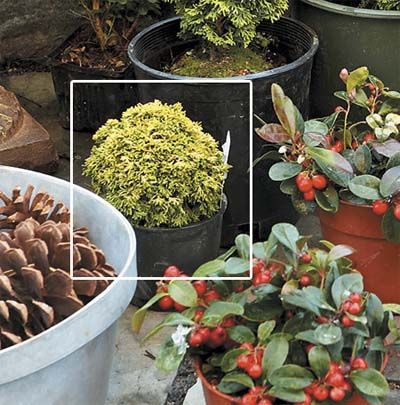
Shown: Cook likes dwarf hinoki cypress (Chamaecyparis obtusa) ‘Golden Sprite,’ with yellow tips on green foliage.
Protecting Plants from Extreme Cold
Even cold-hardy plants may need extra protection during severe weather. Here are some methods to safeguard your garden.
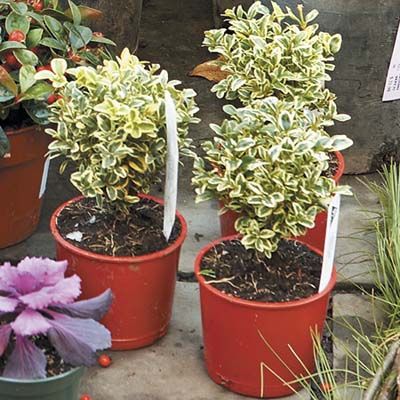
Shown: Variegated boxwood (Buxus sempervirens ‘Variegata’) leaves are outlined in white.
Wrapping and Covering Methods
For vulnerable plants:
- Use burlap or frost cloth to wrap shrubs and small trees
- Create temporary structures with stakes and plastic sheeting
- Apply a thick layer of straw around the base of plants
Remove coverings during the day to allow air circulation and prevent overheating.
Creating Windbreaks and Microclimates
Protect your garden from harsh winds by:
- Installing temporary fencing or screens
- Planting evergreen hedges as permanent windbreaks
- Using existing structures like walls or fences to create sheltered areas
These methods can create warmer microclimates, allowing you to grow less hardy plants in protected spots.
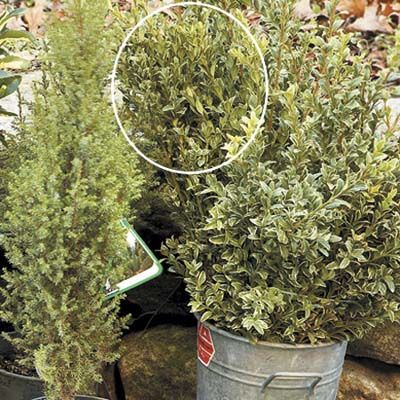
Shown: For all-green evergreens, good choices include Korean boxwood (circled), many hollies, and yews.
Utilizing Mulches Effectively
In addition to mulching roots, consider:
- Mulching around pathways to reduce soil erosion
- Using mulch in garden beds to retain warmth
- Applying mulch to exposed soil to prevent frost heave
Mulching can be a versatile tool in protecting your garden.
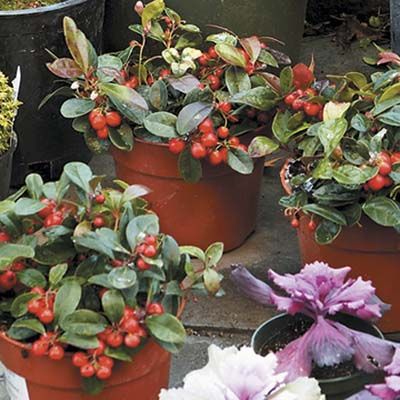
Shown: Wintergreen (Gaultheria procumbens) adds the bright note of red berries.
Incorporating Non-Plant Elements in Winter Gardens
Enhance your winter garden with decorative elements that add interest when plants are dormant.

Shown: Ornamental kale (shown in foreground), a flowerlike broccoli relative that has frilly leaves splashed with various combinations of pink, cream, and green, does well nearly everywhere through early winter, though below-zero temperatures will do it in.
Decorative Twigs and Branches
Incorporate branches for height and texture:
- Curly pussy willow
- Red-twig dogwood
- American winterberry (for red berries)
- White pine boughs
These elements provide structure and color throughout the winter months.

To add a few exclamation points to containers, tuck in branches such as curly pussy willow (Salix caprea ‘Kilmarnock’), ones with colorful bark such as redtwig dogwood (Cornus sericea), and types with red fruit, such as American winterberry (Ilex verticillata).
Winter-Friendly Garden Structures
Add architectural elements to your winter garden:
- Trellises or obelisks for climbing plants
- Decorative stakes or garden art
- Bird feeders and baths to attract wildlife
These structures create visual interest and provide support for plants year-round.
Utilizing Natural Features
Employ natural features such as:
- Stone pathways
- Water features that don’t freeze
- Wooden benches and seating areas
Natural features blend with the winter landscape, offering beauty and functionality.
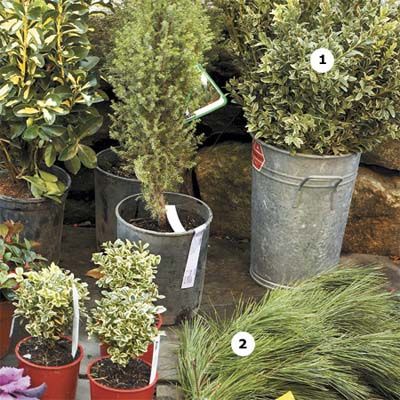
Shown: Cuttings of small-leaved Euonymus japonicus ‘Microphyllus Butterscotch’ (1) or soft-needled white pine (2) are both great additions to your garden.
Transitioning Your Garden From Fall to Winter
Preparing your garden for winter begins in the fall. Take these steps to ensure a beautiful winter landscape:
Preparing Existing Plants for Cold Weather
Help your established plants transition to winter:
- Gradually reduce watering to encourage dormancy
- Apply a layer of mulch around plant bases
- Prune dead or diseased branches
- Protect grafted plants by mounding soil around the graft union
These steps help plants conserve energy and survive the cold months ahead.
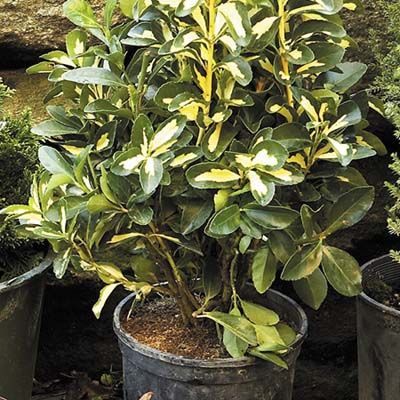
Shown: Euonymus japonicus ‘Golden Maiden,’ which has glossy green leaves splashed with yellow, is a favorite option of Cook’s.
Maintaining Garden Equipment
Ensure your gardening tools and equipment are ready for winter:
- Clean and oil tools to prevent rust
- Store hoses and watering cans to avoid damage from freezing
- Check that any irrigation systems are properly winterized
Having well-maintained equipment means you’ll be ready for any winter gardening tasks.
Our Conclusion
Cold-weather gardening offers a unique opportunity to enjoy your outdoor space year-round. By selecting appropriate containers, choosing hardy plants, and providing proper care, you can create a stunning winter landscape that thrives in challenging conditions.
